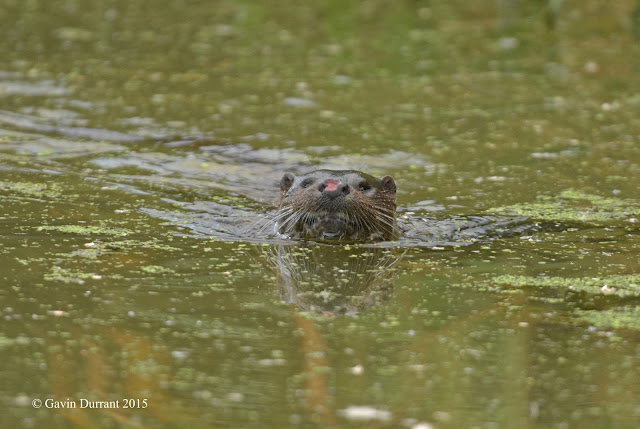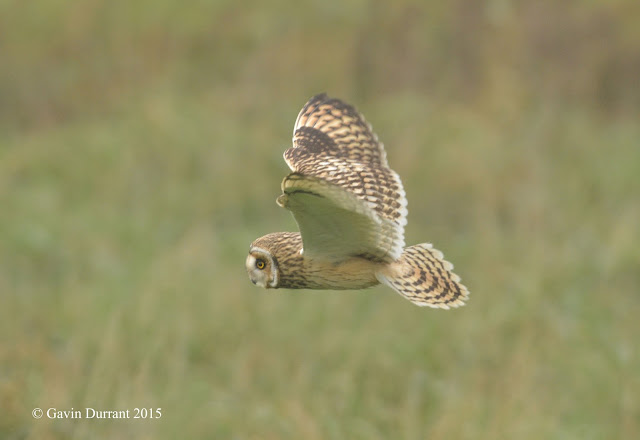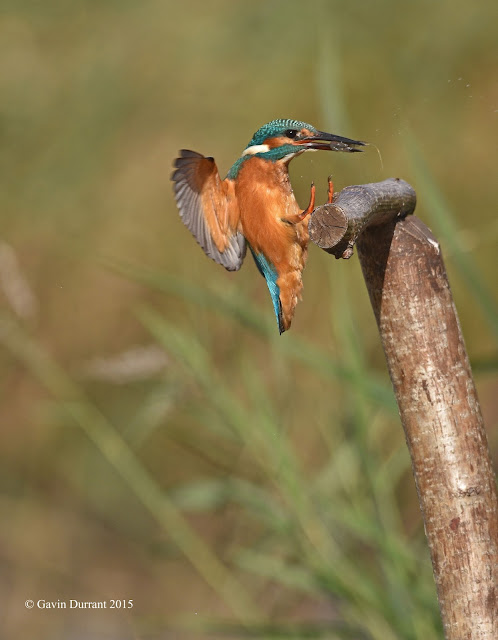Thoughts and photographs of a wildlife enthusiast living and working in the Waveney valley on my trips both in this area and beyond
Sunday, November 15, 2015
OTTER AT CARLTON MARSHES
On Thursday morning I had been over to Minsmere and seen three Otters from Island mere hide but none of them had been close enough for photographs so I moved onto SWT Oulton marshes in the hope of some more Short Eared Owls but there was no sign of any there, finally I decided to call in at SWT Carlton marshes on the way home to have a quick wander around. I walked to the bottom of the car park and turned right, along the footpath, intending to walk along the flood defence wall to the bottom of the reserve before heading back to the car. I only managed to get 50 yards before spotting a disturbance in the water of the dyke and saw a large tail briefly before disappearing under the water, an Otter! Standing still I focused the camera on the water but it was so close that I had difficulty getting the lens to focus when the otter stuck its head up and looked right at me and I got the shot you can see above.
The Otter then moved to my left and I quietly made my way along the bank to get ahead of it and try to get further pictures. This I did several times over the next few minutes struggling to find a clear area of bank to get good photos. The Otter didn't seem to bothered by me and would swim past sometimes within 10 feet of me, too close for the lens to focus, making me wish I had a smaller lens on the camera but eventually I managed to get some shots of the Otter swimming through the duck weed infested dyke. It appeared to be feeding on the numerous Sticklebacks that can be seen in these dykes and by the number of times it was surfacing crunching away was having no trouble catching them. It was amazing to be so close to a wild Otter and not only observe it, but also hear it whilst it was fully aware of my presence.
One thing that could be readily noticed about the Otter was the fact that it had an obviously damaged nose. To my limited knowledge of Otters this may have been caused by fighting with another Otter or possibly through mating if this animal was a female as the males are known to grab and bite the females nose as they mate. At one point the Otter came out of the water to cross the path before going into another dyke system but because it was so close to me I couldn't get any pictures; very frustrating! This encounter certainly made my week and although I regularly see these beautiful animals out in the wild on my wanders to see one at such close quarters was very special.
GREAT WHITE EGRET AT HEN REEDBEDS
Last week I popped over to Hen reedbeds where there had been intermittent reports of a Great White Egret appearing from time to time and indeed a few days beforehand I had seen it being chased by a Grey Heron in the distance over the reeds. Apart from this there was always the chance of seeing a Kingfisher so I arrived at the first hide and prepared to wait with the skies a dismal grey colour and the threat of rain in the air. After half an hour or so a large bird flew over the hide from behind me and I could see that it was the Great White Egret but unfortunately it landed a hundred yards or so away and disappeared into a dyke to feed. A further wait of 20 minutes was rewarded when the bird emerged from the dyke and began to walk through the grass, then it took off and flew towards me in the hide and landed 30 yards away and proceeded to walk into the dyke right in front of me and began to feed. I couldn't believe my luck as normally you only get distant views of this bird as they are very wary so I carefully began to take pictures as it walked up and down the dyke occasionally catching sticklebacks and shrimps from the water.
Gradually these magnificent birds are being seen more regularly in this country and now they have been known to breed in a few locations so the chances of seeing one are increasing and who knows in a few years they might be almost as common as the Little Egret which only 15 or 20 years ago was just as rare. When seen side by side the differences between the two egret species are obvious as the Great White is twice the size of the Little Egret making it the same size as a Grey Heron and also the Great White has a yellow bill whereas the Little Egret has a black bill.
Back to the hide and being such a dull day I was the only person on the reserve and had the egret to myself and fully enjoyed the half an hour or so I had with it feeding in front me before it moved away a little bit and took off flying across the meadow to feed in a dyke on the other side. The Great White Egret is a magnificent bird and I was very lucky to spend time in such close proximity to it that sometimes I couldn't fit the whole bird in my camera frame with the 500mm lens I had with me.
Friday, November 13, 2015
SHORT EARED OWLS AT OULTON MARSHES
The last few weeks has seen a large influx of Short eared Owls from the continent arriving to spend the winter in our milder temperatures and as they arrive they often spend a week or two feeding around here close to the coast, recovering from the long sea crossing before moving on to their winter feeding grounds. A few birds stay around here and SWT Oulton Marshes is one of the more recognised areas where Short eared owls may often be found. I had heard reports that several owls could be seen hunting over the marshes so on a quiet but dull day I walked out and immediately spotted one of these distinctive day hunting owls lazily flying along one of the marshes that border the railway track.
Arriving at the crossing two other photographers were taking pictures of this owl and others that were patrolling up and down the marshes and pretty soon I counted 4 owls within sight all busy hunting for voles in the rough grassland. Every so often two or more of these birds would cross paths and would chase each other off their patch of marshland. Sometimes they would approach quite closely and you could easily make out their bright yellow eyes looking at you. Before leaving I managed to get a shot of one owl perched on a post in the middle of a patch of reeds staring at me which turned out to be my favourite shot of the session.
THE HARES OF HAVERGATE ISLAND
Last month I had the opportunity to go on a trip over to Havergate Island to photograph the Hares that are resident on this small island. Visits to this RSPB reserve are strictly limited to about one a month except during the bird breeding season when all visits are banned to provide a peaceful nesting environment. We arrived at Orford quay in darkness and loaded our gear onto the boat as the dawn was breaking in the east. A 25 minute trip followed before we embarked onto the island and trudged the kilometer or so to the huts where the Hares tend to frequent. This area is a mixture of shingle patches and vegetation dominated by gorse and grass that the Hares seem to love.
The Hares on the island have no natural predators and have very limited fear of humans and indeed as our leader said at the start of the day by the time we were due to to finish the animals would take practically no notice of us at all. The day was breezy which wasn't good news for us as Hares are not keen on the wind which meant that the animals we came across were often crouched down in the undergrowth and not showing well to photograph but as the day progressed they became more active and much easier to see.
As the afternoon went on they emerged to feed on grasses and seeds and gave great views to all of us with cameras which was nice to see as it had been feared a year or so ago that they might have all perished in the devastating tidal surge floods that virtually completely submerged the island at one point. The time came for us to leave and catch the boat back as the light began to fail but the Hares being mainly nocturnal feeders were getting ready to start their day. This island is a wonderful, peaceful, if slightly barren reserve where you can easily imagine that you are much further away from civilization than the 25 minute boat trip would suggest but being so close to the Hares makes it a fantastic experience that I would love to repeat soon.
HEN REEDBED KINGFISHERS
In recent weeks a few local photographers have been spending time at Suffolk Wildlife Trusts Hen Reedbed reserve where Kingfishers have been showing very well. The reeds that border one of the dykes near the first hide have been cut back and a post has been added that the Kingfishers seem to have immediately taken advantage of with the bonus that the post is only a few meters from the hide windows. You have to have patience to see these birds as it may be an hour or more between visits to the post and then they might only stay a few seconds but every now and then you might get lucky and a Kingfisher will sit on the post for a few minutes diving to feed on Sticklebacks and shrimps.
With the sun shining over your shoulder the colours in the plumage of these beautiful birds are amazing. The male bird seems to have the deeper and brighter colours and most, if not all these photographs are of the male which can be differentiated from the female by the solid black bill. Female Kingfishers have and orange area on the lower half of the bill.
After some time taking pictures of the Kingfishers on the perch with either fish or shrimps I thought I would experiment and try to get some action shots. Trying to get photographs as the birds dived into the water proved very difficult and I was not altogether really happy with the results but some of these shots taken as they dived from the post or as they returned to it were much better and worthy of inclusion into this blog. I can see myself returning here on more than one occasion in the coming months!
Sunday, September 20, 2015
BEAUTIFUL BARN OWLS
I've been spending quite a bit of time recently down on the marshes in the lower Waveney valley watching and photographing Barn Owls with varying success but yesterday evening all those hours paid off with my best experience yet with these amazing birds. It all started off quietly enough with an owl appearing as the sun lowered down in the early evening sky and the gentle breeze almost disappeared altogether. The owl hunted over the scrape and surrounding fields at SWT Carlton marshes and I positioned myself by a gate to observe and hope that it would fly within camera range. After a while the Barn owl dropped into the long grass but emerged a few seconds later without any prey and flew directly to my left and perched on a fence post no more than 25 yards away from me.
Moving very slowly I turned round and got behind the camera and took a few shots fully expecting the owl to fly off as soon as the shutter was pressed but to my amazement it turned, looked directly at me as I held my breath and then carried on surveying the field. I took some more shots and the owl moved along the fence post a bit before taking off into the and diving down some 50 yards away. A minute or so so elapsed and then the bird flew up with a vole in its talons and returned to the same perch again.
Not believing my luck I was now furiously snapping away with the camera without the owl taking much notice although it could easily hear the shutter clicking away. It began to swallow the vole and made several attempts to gulp it down but appeared to struggle with the last bit and after a minute or so of trying the vole was regurgitated before somebody walking along the footpath disturbed the owl and it flew off to a nearby tree to consume its meal in peace. By far and away my best encounter with a Barn owl giving me some fantastic photographs to remember it with.
Subscribe to:
Comments (Atom)









































































